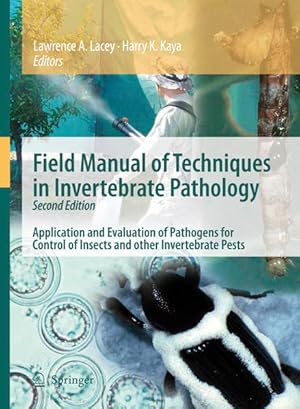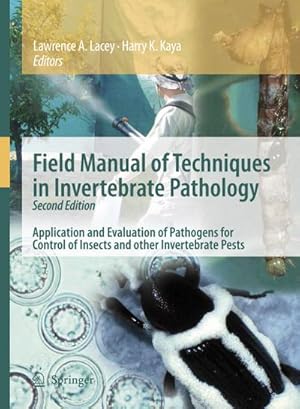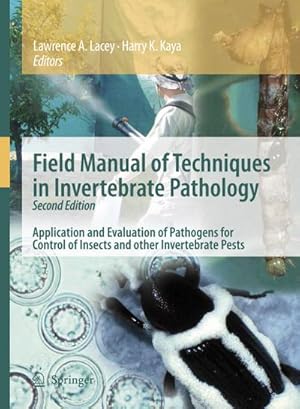field manual techniques invertebrate (3 Ergebnisse)
Produktart
- Alle Produktarten
- Bücher (3)
- Magazine & Zeitschriften
- Comics
- Noten
- Kunst, Grafik & Poster
- Fotografien
- Karten
-
Manuskripte &
Papierantiquitäten
Zustand
Einband
Weitere Eigenschaften
- Erstausgabe
- Signiert
- Schutzumschlag
- Angebotsfoto
Land des Verkäufers
Verkäuferbewertung
-
Field Manual of Techniques in Invertebrate Pathology. Application and Evaluation of Pathogens for Control of Insects and other Invertebrate Pests.
Verlag: Springer, 2007
Anbieter: Antiquariat Thomas Haker GmbH & Co. KG, Berlin, Deutschland
Verbandsmitglied: GIAQ
Buch
Hardcover/Pappeinband. 2nd ed. 886 p. Very good. Shrink wrapped. / Sehr guter Zustand. In Folie verschweißt. Sprache: Englisch Gewicht in Gramm: 2500.
-
Field Manual of Techniques in Invertebrate Pathology : Application and Evaluation of Pathogens for Control of Insects and other Invertebrate Pests
Verlag: Springer Netherlands, 2007
ISBN 10: 1402059329ISBN 13: 9781402059322
Anbieter: AHA-BUCH GmbH, Einbeck, Deutschland
Buch
Taschenbuch. Zustand: Neu. Druck auf Anfrage Neuware - Printed after ordering - The Field Manual of Techniques in Invertebrate Pathology is designed to provide background and instruction on a broad spectrum of techniques and their use in the evaluation of entomopathogens in the field. The second edition of the Field Manual provides updated information and includes two additional chapters and 12 new contributors. The intended audience includes researchers, graduate students, practitioners of integrated pest management (IPM), regulators and those conducting environmental impact studies of entomopathogens. Although it can function as a stand alone reference, the Field Manual is complementary to the laboratory oriented Manual of Techniques in Insect Pathology and to comprehensive texts in insect pathology.The Editors have structured the 40 chapters of the Field Manual into 10 sections to provide the tools required for planning experiments with entomopathogens and their implementation in the field. The basic tools include chapters on the theory and practice of application of microbial control agents (MCAs) (Section I), statistical considerations in the design of experiments (Section II), and three chapters on application equipment and strategies (Section III). Section IV includes individual chapters on the major pathogen groups (virus, bacteria, microsporidia, fungi, and nematodes) and special considerations for their evaluation under field conditions. This section sets the stage for subsequent chapters on the impact of naturally occurring and introduced exotic pathogens and inundative application of MCAs. Twenty-three chapters on the application and evaluation of MCAs in a wide variety of agricultural, forest, domestic and aquatic habitats comprise Section VII of the Field Manual. In addition to insect pests, the inclusion of mites and slugs broadens the scope of the book. Most of the chapters in this section include step by step instructions on handling of inoculum, design of fieldexperiments and experimental plots and application and assessment of efficacy of dozens of MCAs. Several of these chapters include supplementary techniques and media for conducting follow up laboratory studies for confirmation of infection, determination of persistence, etc. The three final chapters include: special consideration for evaluation of Bt transgenic plants (Section VIII); resistance to insect pathogens and strategies to manage resistance (Section IX); and guidelines for evaluating effects of MCAs on nontarget organisms (Section X).Due to uncertainty regarding the future availability of organophosphate and other conventional chemical insecticides, MCAs will play increasingly important roles in IPM. The Field Manual will provide researchers and IPM practitioners with techniques and practical guidance for the study and optimal use of MCAs in a variety of settings.
-
Field Manual of Techniques in Invertebrate Pathology : Application and Evaluation of Pathogens for Control of Insects and other Invertebrate Pests
Verlag: Springer Netherlands, 2007
ISBN 10: 1402059310ISBN 13: 9781402059315
Anbieter: AHA-BUCH GmbH, Einbeck, Deutschland
Buch
Buch. Zustand: Neu. Druck auf Anfrage Neuware - Printed after ordering - The Field Manual of Techniques in Invertebrate Pathology is designed to provide background and instruction on a broad spectrum of techniques and their use in the evaluation of entomopathogens in the field. The second edition of the Field Manual provides updated information and includes two additional chapters and 12 new contributors. The intended audience includes researchers, graduate students, practitioners of integrated pest management (IPM), regulators and those conducting environmental impact studies of entomopathogens. Although it can function as a stand alone reference, the Field Manual is complementary to the laboratory oriented Manual of Techniques in Insect Pathology and to comprehensive texts in insect pathology.The Editors have structured the 40 chapters of the Field Manual into 10 sections to provide the tools required for planning experiments with entomopathogens and their implementation in the field. The basic tools include chapters on the theory and practice of application of microbial control agents (MCAs) (Section I), statistical considerations in the design of experiments (Section II), and three chapters on application equipment and strategies (Section III). Section IV includes individual chapters on the major pathogen groups (virus, bacteria, microsporidia, fungi, and nematodes) and special considerations for their evaluation under field conditions. This section sets the stage for subsequent chapters on the impact of naturally occurring and introduced exotic pathogens and inundative application of MCAs. Twenty-three chapters on the application and evaluation of MCAs in a wide variety of agricultural, forest, domestic and aquatic habitats comprise Section VII of the Field Manual. In addition to insect pests, the inclusion of mites and slugs broadens the scope of the book. Most of the chapters in this section include step by step instructions on handling of inoculum, design of fieldexperiments and experimental plots and application and assessment of efficacy of dozens of MCAs. Several of these chapters include supplementary techniques and media for conducting follow up laboratory studies for confirmation of infection, determination of persistence, etc. The three final chapters include: special consideration for evaluation of Bt transgenic plants (Section VIII); resistance to insect pathogens and strategies to manage resistance (Section IX); and guidelines for evaluating effects of MCAs on nontarget organisms (Section X).Due to uncertainty regarding the future availability of organophosphate and other conventional chemical insecticides, MCAs will play increasingly important roles in IPM. The Field Manual will provide researchers and IPM practitioners with techniques and practical guidance for the study and optimal use of MCAs in a variety of settings.




